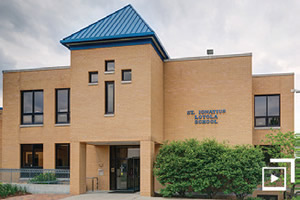New HVAC System Enhances Renovation

Energy efficiency and ease-of-installation sealed the deal for Mitsubishi Electric when it came time to renovate St. Ignatius Loyola School in Cincinnati.
St. Ignatius Loyola School, Cincinnati, is the largest private school in Ohio, serving over 1,000 K-8 students. Many of the classrooms in the school’s original three-story building, which dates back to 1950, didn’t have air conditioning. That created a big problem on hot days. On cold days, the low-pressure boiler consumed a lot of expensive gas — another big problem.
The need for a renovation started with a need for comfort. “This is a building with thick, concrete walls, and some of the classrooms face south. On the third floor, during certain times of the summer when it was over 100 degrees.
For Tim Schweikert, the school’s physical plant manager, “the selected system had to be efficient, cost-effective and do a good job.” It was also important to have a certain aesthetic — what Schweikert called a clean look. “We wanted something that would be unobtrusive, so you wouldn’t see pipes running down the walls.
“When we went out to the Mitsubishi Electric training center in Kentucky, we saw how the units were displayed and we were impressed by their quietness and efficiencies. Ultimately, we thought Mitsubishi Electric was the better unit,” adds Schweikert.
Installation took place over the summer when the students were on break.
Rick Weidner, PE, project engineer, EQS Mechanical says, “It went really well. We ran condensate to existing closets and stayed above the drop ceiling to keep everything concealed. Aesthetically, they had a real clean look when we were finished.”
The school has appreciates the system’s cost savings, thanks to the units’ efficiencies and the school’s practices. There are no thermostats in the individual classrooms, so the centralized controls have “saved us quite a bit of money – perhaps $11,000 a year. You figure, $300 a classroom for 37 classrooms,” Schweikert concludes.
www.mehvac.com
This article originally appeared in the issue of .